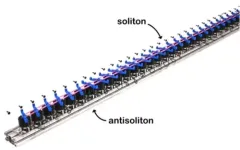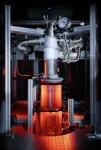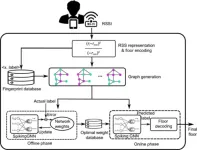(Press-News.org) If it walks like a particle, and talks like a particle… it may still not be a particle. A topological soliton is a special type of wave or dislocation which behaves like a particle: it can move around but cannot spread out and disappear like you would expect from, say, a ripple on the surface of a pond. In a new study published in Nature, researchers from the University of Amsterdam demonstrate the atypical behaviour of topological solitons in a robotic metamaterial, something which in the future may be used to control how robots move, sense their surroundings and communicate.
Topological solitons can be found in many places and at many different length scales. For example, they take the form of kinks in coiled telephone cords and large molecules such as proteins. At a very different scale, a black hole can be understood as a topological soliton in the fabric of spacetime. Solitons play an important role in biological systems, being relevant for protein folding and morphogenesis – the development of cells or organs.
The unique features of topological solitons – that they can move around but always retain their shape and cannot suddenly disappear – are particularly interesting when combined with so-called non-reciprocal interactions. “In such an interaction, an agent A reacts to an agent B differently to the way agent B reacts to agent A,” explains Jonas Veenstra, a PhD student at the University of Amsterdam and first author of the new publication.
Veenstra continues: “Non-reciprocal interactions are commonplace in society and complex living systems but have long been overlooked by most physicists because they can only exist in a system out of equilibrium. By introducing non-reciprocal interactions in materials, we hope to blur the boundary between materials and machines and to create animate or lifelike materials.”
The Machine Materials Laboratory where Veenstra does his research specialises in designing metamaterials: artificial materials and robotic systems that interact with their environment in a programmable fashion. The research team decided to study the interplay between non-reciprocal interactions and topological solitons almost two years ago, when then-students Anahita Sarvi and Chris Ventura Meinersen decided to follow up on their research project for the MSc course ‘Academic Skills for Research’.
Solitons moving like dominoes
The soliton-hosting metamaterial developed by the researchers consists of a chain of rotating rods that are linked to each other by elastic bands - see the figure below. Each rod is mounted on a little motor wich applies a small force to the rod, depending on how it is oriented with respect to its neighbours. Importantly, the force applied depends on which side the neighbour is on, making the interactions between neighbouring rods non-reciprocal. Finally, magnets on the rods are attracted by magnets placed next to the chain in such a way that each rod has two preferred positions, rotated either to the left or the right.
Solitons in this metamaterial are the locations where left- and right-rotated sections of the chain meet. The complementary boundaries between right- and left-rotated chain sections are then so-called ‘anti-solitons’. This is analogous to kinks in an old-fashioned coiled telephone cord, where clockwise and anticlockwise-rotating sections of the cord meet.
When the motors in the chain are turned off, the solitons and anti-solitons can be manually pushed around in either direction. However, once the motors – and thereby the reciprocal interactions – are turned on, the solitons and anti-solitons automatically slide along the chain. They both move in the same direction, with a speed set by the anti-reciprocity imposed by the motors.
Veenstra: “A lot of research has focussed on moving topological solitons by applying external forces. In systems studied so far, solitons and anti-solitons were found to naturally travel in opposite directions. However, if you want to control the behaviour of (anti-)solitons, you might want to drive them in the same direction. We discovered that non-reciprocal interactions achieve exactly this. The non-reciprocal forces are proportional to the rotation caused by the soliton, such that each soliton generates its own driving force.”
The movement of the solitons is similar to a chain of dominoes falling, each one toppling its neighbour. However, unlike dominoes, the non-reciprocal interactions ensure that the ‘toppling’ can only happen in one direction. And while dominoes can only fall down once, a soliton moving along the metamaterial simply sets up the chain for an anti-soliton to move through it in the same direction. In other words, any number of alternating solitons and anti-solitons can move through the chain without the need to ‘reset’.
Motion control
Understanding the role of non-reciprocal driving will not only help us to better understand the behaviour of topological solitons in living systems, but can also lead to technological advances. The mechanism that generates the self-driving, one-directional solitons uncovered in this study, can be used to control the motion of different types of waves (known as waveguiding), or to endow a metamaterial with a basic information processing capability such as filtering.
Future robots can also use topological solitons for basic robotic functionalities such as movement, sending out signals and sensing their surroundings. These functionalities would then not be controlled from a central point, but rather emerge from the sum of the robot’s active parts.
All in all, the domino effect of solitons in metamaterials, now an interesting observation in the lab, may soon start to play a role in different branches of engineering and design.
Video: An endless domino effect (youtube.com)
Publication
Non-reciprocal topological solitons in active metamaterials, Jonas Veenstra, Oleksandr Gamayun, Xiaofei Guo, Anahita Sarvi, Chris Ventura Meinersen, and Corentin Coulais. Nature 2024, DOI: 10.1038/s41586-024-07097-6.
END
An endless domino effect
2024-03-20
ELSE PRESS RELEASES FROM THIS DATE:
ARPA-H appoints Etta Pisano to lead its Advancing Clinical Trials Readiness Initiative
2024-03-20
The Advanced Research Projects Agency for Health (ARPA-H) has appointed Etta D. Pisano, MD, FACR, senior portfolio lead, to build the agency's clinical trial portfolio and lead the ARPA-H Advancing Clinical Trials Readiness Initiative under ARPA-H Resilient Systems Mission Office Director Jennifer Roberts.
The first radiologist to be appointed to such a role, Dr. Pisano is an internationally recognized expert in women's health, breast cancer research, and the use of artificial intelligence in ...
Quantum tornado provides gateway to understanding black holes
2024-03-20
Scientists have for the first time created a giant quantum vortex to mimic a black hole in superfluid helium that has allowed them to see in greater detail how analogue black holes behave and interact with their surroundings.
Research led by the University of Nottingham, in collaboration with King’s College London and Newcastle University, have created a novel experimental platform: a quantum tornado. They have created a giant swirling vortex within superfluid helium that is chilled to the lowest possible temperatures. Through the observation of minute wave dynamics on the superfluid’s surface, the research team has shown that these quantum ...
Introducing Floorlocator: a game-changer in indoor navigation technology
2024-03-20
Researchers have developed FloorLocator, a breakthrough in indoor navigation technology, which combines the high efficiency of Spiking Neural Networks (SNNs) with the advanced learning capabilities of Graph Neural Networks (GNNs). This innovative approach ensures remarkable accuracy and scalability for floor localization, crucial for enhancing emergency responses, indoor positioning, and personalized recommendation systems.
Indoor positioning is transforming with applications demanding precise location tracking. Traditional methods, including fingerprinting and sensor-based techniques, though widely used, face significant drawbacks such as the ...
New survey on deep learning solutions for cellular traffic prediction
2024-03-20
The bustling streets of a modern city are filled with countless individuals using their smartphones for streaming videos, sending messages and browsing the web. In the era of rapidly expanding 5G networks and the omnipresence of mobile devices, the management of cellular traffic has become increasingly complex. To address this challenge, mobile network operators need methods for the accurate prediction of cellular traffic. A comprehensive survey published 5 Jan. in Intelligent Computing explores deep learning techniques for cellular traffic prediction.
Better cellular traffic prediction would enhance intelligent 5G network construction and resource management, thereby ...
Cellular architecture of lesions in MS now mapped out
2024-03-20
Using advanced methodology, scientists in Sweden were able to reveal at the cellular level how lesions in multiple sclerosis develop. The new results are presented in the journal Cell by researchers from Karolinska Institutet and Stockholm University.
Over 1,8 million people worldwide are diagnosed with multiple sclerosis, MS. In this disease, the body's immune cells attack the cells that form myelin, the so-called oligodendrocytes, which belong to the group of glial cells. Without myelin, signals between nerve cells cannot travel as fast as ...
ADHD medications and work disability and mental health outcomes
2024-03-20
About The Study: In this Swedish nationwide cohort study of 221,000 individuals with attention-deficit/hyperactivity disorder (ADHD), the use of ADHD medication was associated with fewer hospitalizations for both psychiatric and non-psychiatric morbidity and lower suicidal behavior.
Authors: Heidi Taipale, Ph.D., of the Karolinska Institutet in Stockholm, is the corresponding author.
To access the embargoed study: Visit our For The Media website at this link https://media.jamanetwork.com/
(doi:10.1001/jamanetworkopen.2024.2859)
Editor’s Note: Please see the article for additional information, including ...
Electrocardiographic findings in female professional basketball athletes
2024-03-20
About The Study: This study that included 173 Women’s National Basketball Association athletes provides reference electrocardiographic (ECG) data for elite female basketball athletes. International criteria–defined training-related findings were common, whereas abnormal ECG findings were rare in this athlete group. These reference data may assist basketball programs and health care professionals using ECGs in screening for female athletes and may be used as a stimulus for future female-specific ECG ...
Experts warn climate change will fuel spread of infectious diseases
2024-03-20
A team of infectious diseases experts called for more awareness and preparedness in the medical field to deal with the impact of climate change on the spread of diseases. Their article, published today in JAMA raises the alarm about the emergence and spread of harmful pathogens. The authors also urge the medical community to update their education and training and take steps to combat global warming.
“Clinicians need to be ready to deal with the changes in the infectious disease landscape,” said lead author George R. Thompson. Thompson is a professor at the UC Davis School of Medicine in the Department of Internal Medicine, Division of Infectious Diseases, and the ...
Researchers report on the effectiveness of skin biopsy to detect Parkinson’s and related neurodegenerative diseases
2024-03-20
BOSTON – In a paper published in the Journal of the American Medical Association (JAMA), neurologists at Beth Israel Deaconess Medical Center (BIDMC) showed that a simple skin biopsy test detects an abnormal form of alpha-synuclein, the pathological hallmark of Parkinson’s disease and the subgroup of neurodegenerative disorders known as synucleinopathies, at high positivity rates. Results from this landmark study sponsored by the National Institutes of Health (NIH) validate this cutaneous method as a reliable and convenient tool to help physicians make more accurate diagnoses ...
Treating anxiety, depression in people with heart disease reduced ER visits, hospitalizations
2024-03-20
Research Highlights:
Treating anxiety and depression significantly reduced hospital readmission and emergency room visits in people with heart disease.
This may be the first study to show that treating anxiety and depression with medication or psychotherapy has a significant impact on heart disease outcomes.
People with heart disease who are also diagnosed with anxiety or depression may benefit from mental health treatment to improve cardiovascular outcomes, the study researchers noted.
Embargoed until 4 a.m. CT/5 a.m. ET Wednesday, ...






